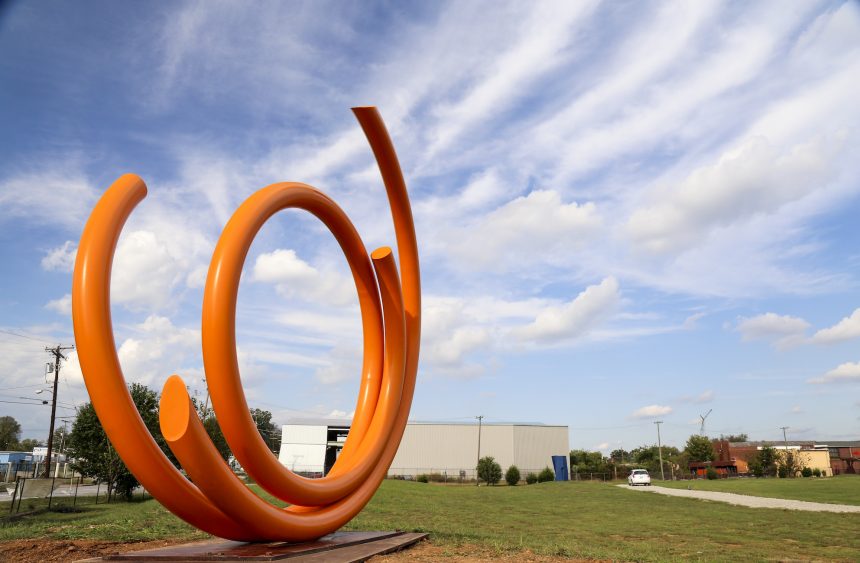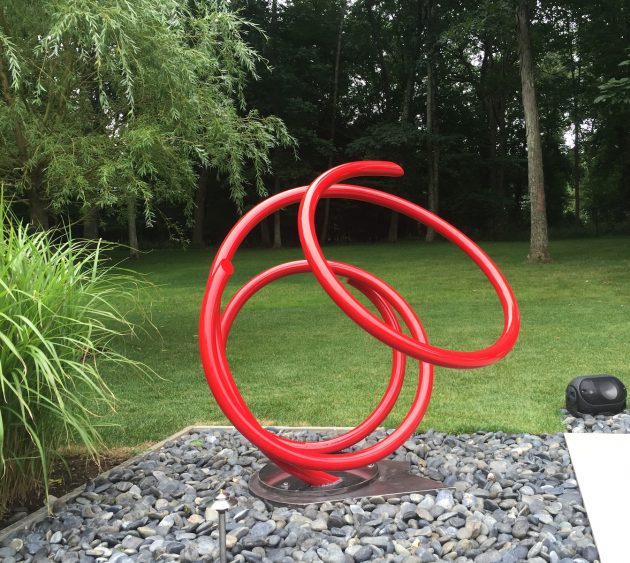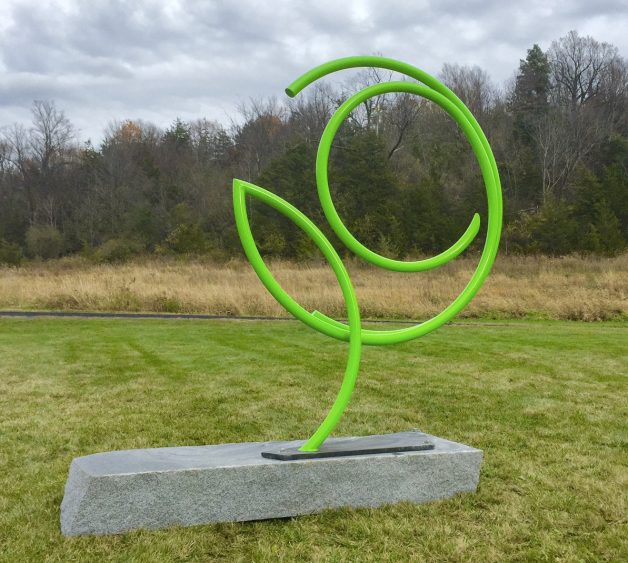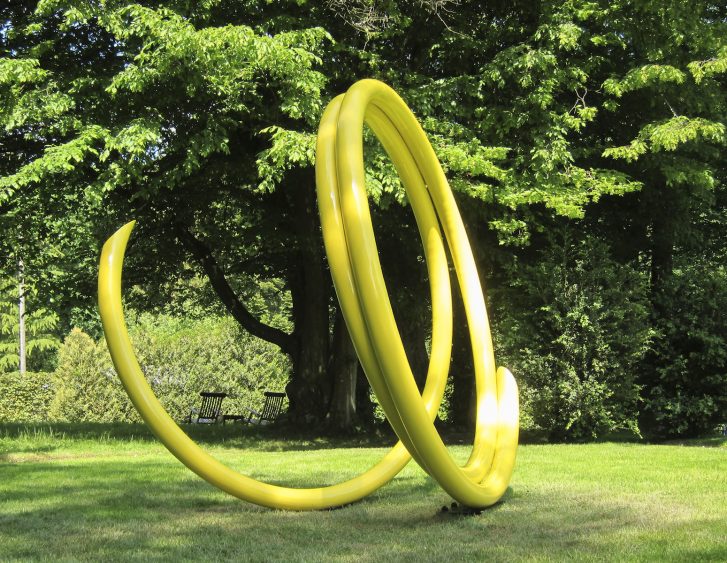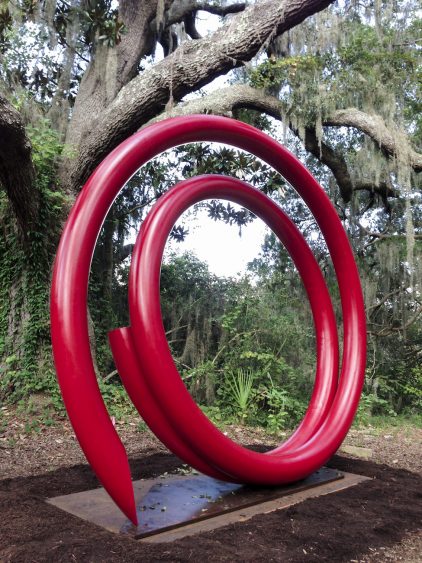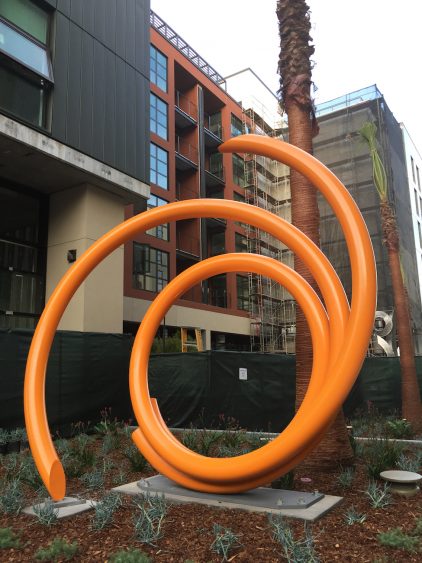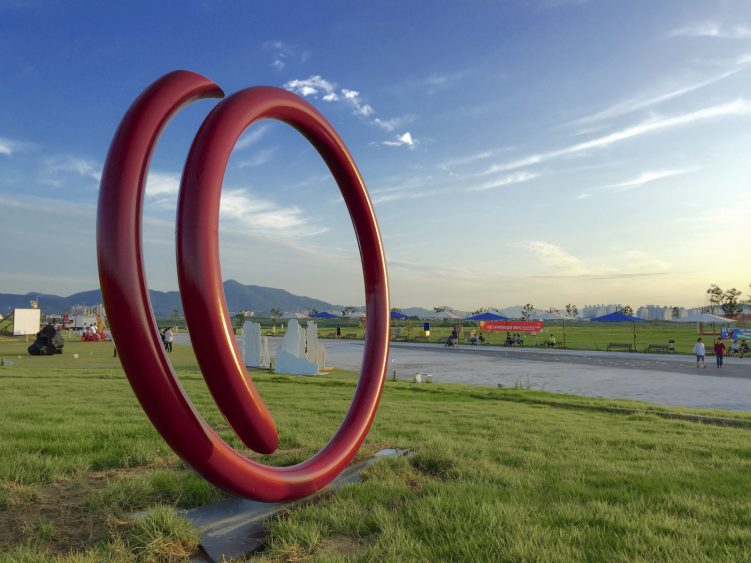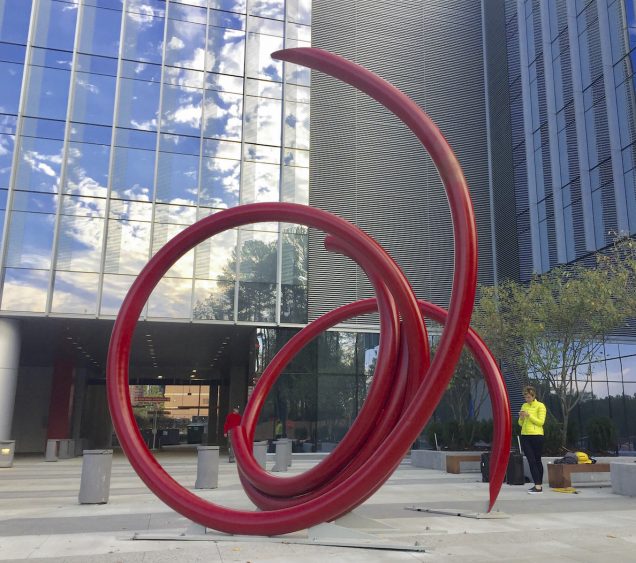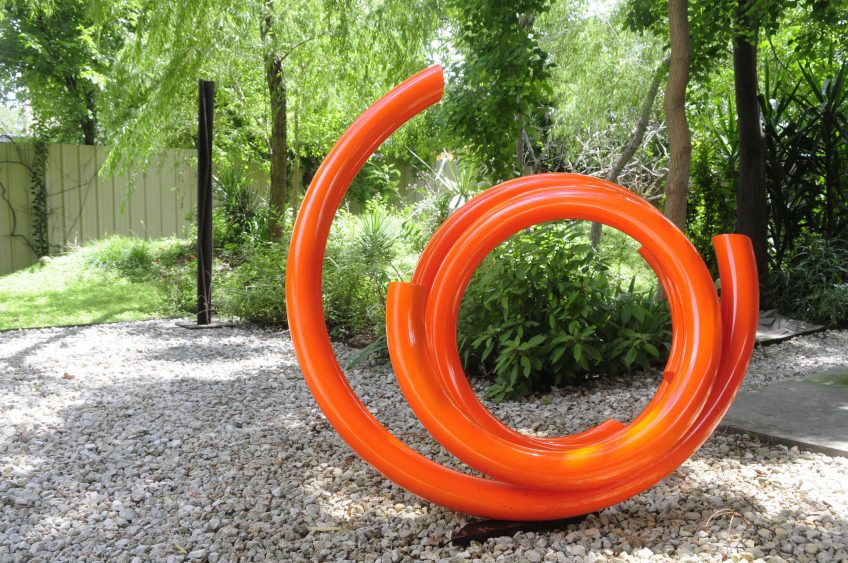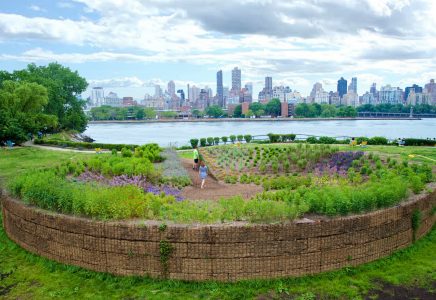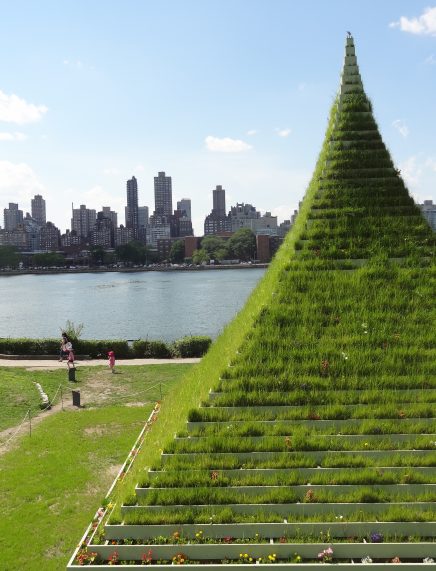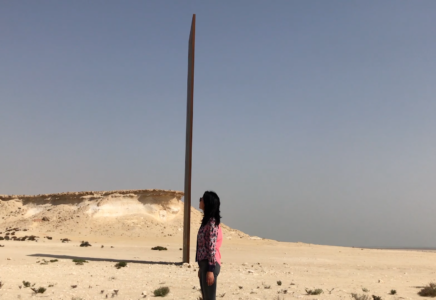Interview with John Clement
The result of studying and working with such acclaimed artists as Mark di Suvero and John Henry, John Clement’s geometric work certainly follows in a similar position of large-scale Constructivist-inspired sculpture, and yet breaks the boundaries of the genre by constantly playing with the ideas of form and space in curvilinear compositions. His work juxtaposes a variety of playful steel coils and arcs that, layered on top of one another, take on a life of their own. While today Clement focuses primarily on large-scale outdoor work, reminiscent of both di Suvero and Henry’s association with public sculpture, his smaller works are evocative of a parallel yet unique joyfulness. Viewers cannot help but think that the works are, on their own volition, about to swivel on their bases and spin around in space. Of course, the outdoor art is necessarily different, requiring a different scale and entirely public conception of the role sculpture should play in an open space. Generally, Clement’s dynamic and dramatic union of form, line and negative space emphasizes the impression of implied movement. After receiving a BA from the University of Pennsylvania in 1992, Clement studied briefly at New York’s School of Visual Arts before moving on to work with di Suvero and Henry in the 1990s. In addition to numerous gallery exhibitions, Clement has also completed many important public commissions and installations across the United States and abroad. He currently lives in Brooklyn and his studio is located close by di Suvero’s complex near Socrates Park.
You studied at a major American liberal arts university: the University of Pennsylvania. How did it prepare you for your sculpture career?
Well, in my opinion there really isn’t much that can prepare one for a career as a sculptor. There are so many moving parts, dynamics, and experiences, etc., that make sculpture a hard medium to teach. There is a rich tradition of oral history in sculpture: techniques, ideas, methodologies that just can’t be taught in formal settings or even learned from reading accounts of various skills and processes; the components of the art literally need to be experienced and learned hands on. That being said, I do know a great deal of individuals from Penn who are real pioneers: free thinkers who are not afraid, no matter what the profession, to forge new paths. Having formed relationships with folks like these is a great help when feeling alone and adrift in uncharted waters.
When you made your way back to New York from college, what did you do? When did you start working for Mark di Suvero?
I had a plethora of odd and ends jobs: bar-back, assistant to a cabinet maker, artist assistant (to a sculptor in Chinatown who had me cut the fur off of fur coats and glue to mannequins…no shit), waiter, tool room attendant at a NYC art school… and others I’d care not to discuss! I started working for Mark di Suvero about a year and a half after landing in NYC, 1992, a connection made by sculptor Joel Perlman. I am forever grateful for this, as it literally changed the course of my life.
What was it like to work for di Suvero? What kinds of skills did you pick up there? What was it like to live in his compound on the water, across from Socrates Park? How did you find your current space on the edge of the waterfront in Astoria?
In a word fantastic/amazing/enlightening… Although I was a newcomer to the art world, and really didn’t even know who Mark was. But I did know that I was immersing myself in something very large, very exciting, and very historical. Oddly enough, I was able to secure my current studio (a block away from Mark’s studio in Long Island City) through the contacts I made (and had kept) during my days as his assistant. There was and still is a very special aura around what he has done in the area (with his studio, as well as Socrates Sculpture Park, which he founded), and the folks in that area are very grateful to Mark and the artists who have come through. In my case I was just passing by one afternoon while hunting for a new studio, and while talking to an old friend in the area I learned about an available studio. Within five minutes of seeing the space and talking to the owners (whose father I knew from the area twenty years ago), I had the keys and a new studio.
You are a welded-steel sculptor. This seems to be a dying art–as you mentioned, you were the only one your age in a recent competition (the other artists were a generation older). Why do you think this is? Is it partially because studio space in New York City has become so expensive? Or are there other reasons?
Well, sculpture is hard. Physically, mentally, financially, you name it! Some way or another I have been fortunate enough to keep going. Most of the folks I knew twenty years ago are gone. Some are still making art, but far, far from here. There used to be a solid support system, a cohesive group, but it’s greatly diminished now.Costs of doing it are a major factor. In NYC to keep a studio in which one can cut and weld steel is almost impossible now. In addition the newer technologies (CNC routers, digital printing, etc.) are allowing for some very, very cool stuff to be made with minimal physical effort and no real workshop! I’m sure I’m simplifying the answer, as there has to be other factors involved, but I’m not a sociologist (at least not professionally), so I can’t fully answer.
You have done public art both in urban and landscape settings. How are the two different? How do you determine the site of a work in a relatively rural setting?
I have many works in both settings. There is quite a contrast to how works are seen, given a pastoral landscape setting versus an urban setting of architectural structures…. Re siting a piece in a rural setting, its almost impossible to compete with nature. My approach is to see how the work frames the landscape around it. My pieces very often have open, negative space, and I try to encourage viewers to look at the landscape through the work just as much as looking at the work in the landscape. This approach makes it an active participant in the setting as opposed to a foreign object.
How do you feel about making public art? How does it differ from selling a work privately or through a gallery?
Public art is a totally different animal. Taking the piece out of a controlled environment (where a close relationship with a client/dealer lends itself to more intimate discourse) and into the public realm, where anyone and EVERYONE has an opinion about it, is an intense experience. I have had the greatest praise, heard the most insightful comments as well as sustained the nastiest attacks via my work in the public realm. You have to be able to love it all.
What are some of the skills necessary for welding? Is the patina of the work of great concern in art that stays outdoors? How do you ensure the patina won’t wear off?
Welding is actually pretty easy. I find knitting and sewing much harder. I think what can intimidate people is that it looks intense, and you are dealing with high voltage and intense heat, but if done properly its very safe. To answer the second question: yes, patina/coatings are very important. But a steel sculpture, just like anything else, will need some level of maintenance over its lifetime. Oxidization is forever ongoing, and steel, if not cared for, will oxidize. Overtime paint will fade, but it’s easily remedied with care and maintenance. However, as Brancusi said: “It’s all temporary…as we are between ice ages.” Ha ha!
Who are some of the artists, besides di Suvero, you have worked with and been influenced by? Who are some of the internationally respected artists that move you?
As far as working with and being around other sculptors, there are only a few: Mark, John Henry, Andrew Ginzel, and Joel Perlman have all given me mentoring and tutelage that has been invaluable throughout my career. However I am also constantly inspired by some of my contemporaries like Peter Lundberg, Colin Chase, Sarah Sze, Jean Shin and others.
Name two recent projects that you are particularly happy about? What did the completion of these projects entail? Do you have a preference for working in America or outside the country?
This last year has been very busy, with numerous installs, public and private across the country. I guess the piece Once Upon a Time, a recent large-scale commission for Atlanta, as well as Casper, a recent commission for San Francisco, were very fulfilling, but they go hand in hand with the constant exploration and development of small- and mid-scale works in the studio. The works, no matter what the scale, are all tied together.
How do you feel about sculpture generally now, especially in America. It is hard to find gallery shows of sculpture, I imagine for financial reasons. Is the state of the art in trouble?
Gallery shows are attainable, but the overall sentiment I get from sculptors is that they are not so eager to have them too often as they end up being costly, and the sales usually do not cover the costs. Exposure is never bad, and shows are great to have, but the market for private buyers of mid-career sculptors seems to be down. That being said, an exhibition is a great motivator to get your butt in gear, challenge yourself to get your new works going, and bravely put up the show.
What’s coming up in the next year? What project are you most excited about?
I have some commissions in the works for Manhattan, Wisconsin, and Washington D.C., as well as a new series of smaller works in the studio. There is a catalogue in the works as well. The works span a variety of scales (from 18” to 18’ in various pipe diameters ); working on them and getting them installed will be great.
